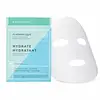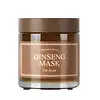What's inside
What's inside
 Key Ingredients
Key Ingredients

 Benefits
Benefits

 Concerns
Concerns

 Ingredients Side-by-side
Ingredients Side-by-side

Water
Skin ConditioningGlycerin
HumectantDipropylene Glycol
Humectant1,2-Hexanediol
Skin ConditioningTrehalose
HumectantBetaine
HumectantPanthenol
Skin ConditioningEthylhexylglycerin
Skin ConditioningTocopheryl Acetate
AntioxidantButylene Glycol
HumectantPEG-60 Hydrogenated Castor Oil
EmulsifyingPropanediol
SolventInositol
HumectantSodium Hyaluronate Crosspolymer
HumectantTaurine
BufferingHydrolyzed Glycosaminoglycans
HumectantSodium Hyaluronate
HumectantAngelica Gigas Root Extract
Skin ConditioningCimicifuga Racemosa Root Extract
AntimicrobialGlycyrrhiza Glabra Root Extract
BleachingMorus Alba Bark Extract
Skin ConditioningPaeonia Lactiflora Root Extract
Skin ConditioningPhellinus Linteus Extract
Skin ConditioningPolygonum Multiflorum Root Extract
Skin ConditioningScutellaria Baicalensis Root Extract
AstringentSesamum Indicum Seed Extract
Skin ConditioningSophora Flavescens Root Extract
AntioxidantBenzyl Glycol
SolventHydrolyzed Hyaluronic Acid
HumectantHyaluronic Acid
HumectantXanthan Gum
EmulsifyingParfum
MaskingRaspberry Ketone
MaskingWater, Glycerin, Dipropylene Glycol, 1,2-Hexanediol, Trehalose, Betaine, Panthenol, Ethylhexylglycerin, Tocopheryl Acetate, Butylene Glycol, PEG-60 Hydrogenated Castor Oil, Propanediol, Inositol, Sodium Hyaluronate Crosspolymer, Taurine, Hydrolyzed Glycosaminoglycans, Sodium Hyaluronate, Angelica Gigas Root Extract, Cimicifuga Racemosa Root Extract, Glycyrrhiza Glabra Root Extract, Morus Alba Bark Extract, Paeonia Lactiflora Root Extract, Phellinus Linteus Extract, Polygonum Multiflorum Root Extract, Scutellaria Baicalensis Root Extract, Sesamum Indicum Seed Extract, Sophora Flavescens Root Extract, Benzyl Glycol, Hydrolyzed Hyaluronic Acid, Hyaluronic Acid, Xanthan Gum, Parfum, Raspberry Ketone
Glycerin
HumectantPanax Ginseng Root Extract 3.97%
EmollientButylene Glycol
HumectantPanax Ginseng Seed Oil
EmollientGlycyrrhiza Uralensis Root Extract
Skin ConditioningPaeonia Albiflora Root Extract
Skin ConditioningAngelica Gigas Root Extract
Skin ConditioningRheum Palmatum Root Extract
AstringentAngelica Pubescens Root Extract
Skin ConditioningSchizonepeta Tenuifolia Extract
Skin ConditioningPhellodendron Amurense Bark Extract
Skin ConditioningMalt Extract
Skin ProtectingEthoxydiglycol
HumectantHydrolyzed Glycosaminoglycans
HumectantHyaluronic Acid
HumectantBoswellia Serrata Resin Extract
Smoothing1,2-Hexanediol
Skin ConditioningWater
Skin ConditioningEthylhexylglycerin
Skin ConditioningPEG-60 Hydrogenated Castor Oil
EmulsifyingIsohexadecane
EmollientPolysorbate 80
EmulsifyingSodium Acrylate/Sodium Acryloyldimethyl Taurate Copolymer
Emulsion StabilisingGlycerin, Panax Ginseng Root Extract 3.97%, Butylene Glycol, Panax Ginseng Seed Oil, Glycyrrhiza Uralensis Root Extract, Paeonia Albiflora Root Extract, Angelica Gigas Root Extract, Rheum Palmatum Root Extract, Angelica Pubescens Root Extract, Schizonepeta Tenuifolia Extract, Phellodendron Amurense Bark Extract, Malt Extract, Ethoxydiglycol, Hydrolyzed Glycosaminoglycans, Hyaluronic Acid, Boswellia Serrata Resin Extract, 1,2-Hexanediol, Water, Ethylhexylglycerin, PEG-60 Hydrogenated Castor Oil, Isohexadecane, Polysorbate 80, Sodium Acrylate/Sodium Acryloyldimethyl Taurate Copolymer
Ingredients Explained
These ingredients are found in both products.
Ingredients higher up in an ingredient list are typically present in a larger amount.
1,2-Hexanediol is a synthetic liquid and another multi-functional powerhouse.
It is a:
- Humectant, drawing moisture into the skin
- Emollient, helping to soften skin
- Solvent, dispersing and stabilizing formulas
- Preservative booster, enhancing the antimicrobial activity of other preservatives
We don't have a description for Angelica Gigas Root Extract yet.
Butylene Glycol (or BG) is used within cosmetic products for a few different reasons:
Overall, Butylene Glycol is a safe and well-rounded ingredient that works well with other ingredients.
Though this ingredient works well with most skin types, some people with sensitive skin may experience a reaction such as allergic rashes, closed comedones, or itchiness.
Learn more about Butylene GlycolEthylhexylglycerin (we can't pronounce this either) is commonly used as a preservative and skin softener. It is derived from glyceryl.
You might see Ethylhexylglycerin often paired with other preservatives such as phenoxyethanol. Ethylhexylglycerin has been found to increase the effectiveness of these other preservatives.
Glycerin is already naturally found in your skin. It helps moisturize and protect your skin.
A study from 2016 found glycerin to be more effective as a humectant than AHAs and hyaluronic acid.
As a humectant, it helps the skin stay hydrated by pulling moisture to your skin. The low molecular weight of glycerin allows it to pull moisture into the deeper layers of your skin.
Hydrated skin improves your skin barrier; Your skin barrier helps protect against irritants and bacteria.
Glycerin has also been found to have antimicrobial and antiviral properties. Due to these properties, glycerin is often used in wound and burn treatments.
In cosmetics, glycerin is usually derived from plants such as soybean or palm. However, it can also be sourced from animals, such as tallow or animal fat.
This ingredient is organic, colorless, odorless, and non-toxic.
Glycerin is the name for this ingredient in American English. British English uses Glycerol/Glycerine.
Learn more about GlycerinHyaluronic acid is naturally found in healthy skin. It is a humectant, meaning it draws moisture to your skin.
This ingredient helps hydrate, soothe, and protect the skin.
What makes hyaluronic acid so hydrating? It has the capacity to bind or hold large amounts of water.
Fun fact: It is already naturally found in our bodies, such as the fluids of our eyes and our joints.
Studies find this ingredient to have anti-inflammatory and anti-microbial properties. This can help speed up wound-healing.
Hyaluronic acid can be irritating if the molecule has a low-molecular weight, or if the molecules are small.
One study found low-molecular weight hyaluronic acid to be pro-inflammatory, meaning some people may experience irritation. This is because our bodies use hyaluronic acid in the wound-healing process to signal to our bodies, via irritation, that something needs healing.
The same study found high-molecular weight hyaluronic acid to be anti-inflammatory.
These are some other common types of Hyaluronic Acid:
Learn more about Hyaluronic AcidWe don't have a description for Hydrolyzed Glycosaminoglycans yet.
Peg-60 Hydrogenated Castor Oil comes from hydrogenated castor oil. It is a solubilizer and emulsifier.
As a solubilizer, it helps dissolve ingredients into a water-based version. It is also an emulsifer. Emulsifier help prevent oils and water from separating. Both these properties help create evenly-spread and uniform products.
Basically, Peg-60 Hydrogenated Castor Oil helps hold ingredients together.
Learn more about PEG-60 Hydrogenated Castor OilWater. It's the most common cosmetic ingredient of all. You'll usually see it at the top of ingredient lists, meaning that it makes up the largest part of the product.
So why is it so popular? Water most often acts as a solvent - this means that it helps dissolve other ingredients into the formulation.
You'll also recognize water as that liquid we all need to stay alive. If you see this, drink a glass of water. Stay hydrated!
Learn more about Water